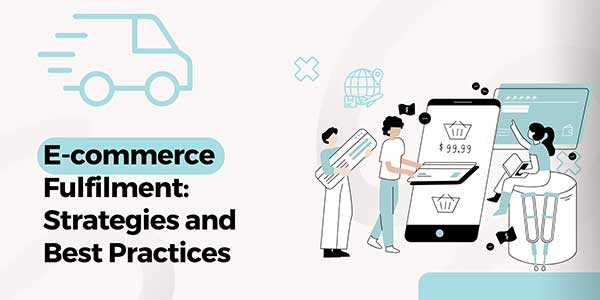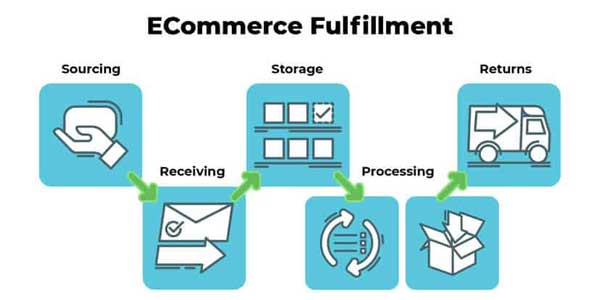
E-commerce fulfillment has become a crucial element in the retail industry, especially highlighted during the COVID-19 pandemic. With the shift in consumer behavior towards online shopping, retailers need to establish efficient and effective e-commerce fulfillment processes. These processes, which include receiving, picking, packing, and shipping online orders, often require collaboration with a skilled logistics company. This partnership is vital for ensuring that the complex logistics of e-commerce fulfillment are managed effectively, contributing to improved customer satisfaction, competitive advantage, and increased business profitability.
This blog aims to provide comprehensive insights into the strategies and best practices for e-commerce fulfillment. By understanding and implementing these practices, businesses can improve customer satisfaction, streamline operations, and enhance their profitability and growth.
Table of Contents
Understanding E-commerce Fulfillment:
E-commerce fulfillment refers to the entire process of handling online orders, starting from inventory management to the final delivery to the customer. This process includes steps like order processing, warehousing, picking and packing items, shipping, and managing returns. It can be carried out in-house or outsourced to a third-party logistics provider.
Key Components Of E-Commerce Fulfillment:
- Order Processing: This involves receiving and validating customer orders, checking inventory, and preparing the orders for dispatch.
- Inventory Management: Effective management of inventory ensures products are in stock and available for order fulfillment.
- Warehousing: This is where products are stored, often in strategically located distribution centers for optimized shipping.
- Picking and Packing: Selecting the correct items from inventory and packing them for shipment.
- Shipping and Delivery: Transporting the order to the customer’s location with various carrier options.
- Returns Management: Handling product returns and exchanges efficiently to maintain customer satisfaction.
Impact On Customer Experience And Business Growth:
Efficient fulfillment directly influences customer loyalty and brand reputation. Fast and accurate delivery builds customer trust, leading to repeat business and positive word-of-mouth marketing. Additionally, optimizing e-commerce fulfillment can significantly reduce operational costs and enable businesses to handle seasonal demand fluctuations and lower return rates effectively.
Challenges In E-Commerce Fulfillment:
Common Challenges:
- Inventory Management: Keeping accurate stock levels to avoid overstocking or understocking.
- Shipping Logistics: Ensuring fast, reliable delivery while managing shipping costs.
- Return Policies: Efficiently managing returns without compromising customer satisfaction.
- Scaling Issues: Adapting fulfillment processes to handle fluctuating demand, especially during peak seasons.
Real-World Examples:
- The surge in online shopping during the COVID-19 pandemic put a strain on fulfillment systems, highlighting issues such as outdated tools and systems not designed for sudden spikes in demand.
- Retailers like Walmart have innovated by launching ‘pop-up’ e-commerce fulfillment centers within their regular distribution centers to handle increased online orders more efficiently.

Essential Strategies For Efficient Fulfillment:
Inventory Management:
Best Practices for Maintaining Accurate Inventory Levels
- Regular Audits: Conduct frequent audits to ensure inventory accuracy. This can be done annually, quarterly, or even through cycle counting, where a portion of the inventory is counted on a rotating schedule.
- Real-Time Tracking: Implement real-time inventory tracking systems to provide up-to-date information on stock levels, helping to prevent overstocking or stockouts.
Techniques for Demand Forecasting and Inventory Optimization
- Historical Sales Data Analysis: Use past sales data to predict future demand patterns.
- Seasonal Trend Analysis: Account for seasonal variations in demand to optimize inventory levels.
- Use of AI and Machine Learning: Implement AI-driven tools for advanced forecasting and inventory optimization, which can analyze complex data patterns to predict demand more accurately.
Warehousing Solutions:
Importance of Strategic Warehouse Locations
- Proximity to Customers: Choose locations near key customer bases to reduce shipping times and costs.
- Access to Transportation Networks: Select locations with good access to major transportation routes for efficient distribution.
Automation and Technology in Warehousing
- Automated Storage and Retrieval Systems (AS/RS): Implement automation in storage and retrieval to increase warehouse efficiency and reduce labor costs.
- Warehouse Management Systems (WMS): Utilize WMS to optimize warehouse operations, including inventory tracking, picking processes, and space utilization.
Optimizing Order Processing:
Streamlining the Order Processing Workflow
- Automated Order Entry Systems: Minimize manual data entry to reduce errors and speed up the order processing time.
- Batch Processing: Group similar orders for more efficient picking and packing.
Technology Solutions for Order Management
- Integrated Order Management Systems (OMS): Implement an OMS that can integrate with other systems like CRM and WMS for a seamless workflow.
- Customer Communication Tools: Use automated tools for customer notifications about order status, which enhances customer experience and reduces service inquiries.
Effective Shipping And Delivery:
Choosing the Right Shipping Partners and Methods
- Carrier Selection Based on Delivery Needs: Choose shipping partners based on factors like speed, cost, geographic coverage, and reliability.
- Use of Multiple Carriers: Diversify carrier options to balance cost and delivery speed, and to ensure coverage in different regions.
Balancing Speed and Cost in Shipping Decisions
- Hybrid Shipping Models: Combine different shipping methods (like ground and air) to balance speed and cost.
- Dynamic Shipping Rates: Implement dynamic shipping rates based on factors such as distance, package size, and speed requirements.
Managing Returns Effectively:
Streamlining the Returns Process
- Easy-to-Use Return Portals: Provide customers with an easy-to-use online portal for processing returns.
- Automated Return Label Generation: Implement systems that allow for the automatic generation of return labels to streamline the process.
Policies that Satisfy Customers and Protect Profit Margins
- Clear Return Policy: Have a clear and concise return policy that satisfies customers but also considers the cost implications for the business.
- Restocking and Refurbishment: Efficiently manage restocking and refurbishment of returned items to minimize losses.
Leveraging Technology In E-Commerce Fulfillment:
Role of Technology in Enhancing Fulfillment Operations
- Automation of Repetitive Tasks: Use technology to automate repetitive and manual tasks in order processing, inventory management, and shipping.
- Data Analytics: Utilize data analytics for insights into customer behavior, inventory trends, and operational efficiency.
Overview of Useful Software and Tools
- Inventory Management Systems: Tools like NetSuite, Zoho Inventory, or TradeGecko for inventory tracking and management.
- Customer Relationship Management (CRM) Systems: CRM tools like Salesforce or HubSpot for maintaining customer data and improving service.
- Order Processing Software: Systems like ShipStation or QuickBooks Commerce for efficient order processing and shipping management.
Future Trends In Technology For E-Commerce Fulfillment:
- IoT and Smart Warehousing: Implementation of IoT for real-time tracking and smart warehousing solutions.
- Robotics and Drones: Increased use of robotics for picking and packing, and drones for last-mile delivery.
- Blockchain for Supply Chain Transparency: Utilizing blockchain technology for enhanced transparency and security in the supply chain.
By adopting these strategies and leveraging technology, businesses can achieve efficient e-commerce fulfillment, leading to enhanced customer satisfaction, operational efficiency, and overall business growth.
Conclusion:
Mastering e-commerce fulfillment is essential for the growth and profitability of online retail businesses. Implementing efficient strategies in various areas of e-commerce, from inventory management to shipping and returns, significantly enhances customer satisfaction and operational efficiency. Additionally, the integration of technology and collaboration with a skilled logistics company is pivotal in navigating the complexities of e-commerce fulfillment and positioning businesses for sustainable success in the digital marketplace.

 About the Author:
About the Author:
















Be the first to write a comment.